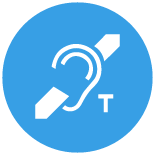
Hearing loop systems and assistive listening solutions
Our partner Ampetronic is a world leader in design and manufacture of audio induction loop system, also known as hearing loop systems or T loops an established technology that helps with hearing loss to increase the clarity of amplified sound in any busy environment by working in conjunction with hearing aids and cochlear implants.
All Ampetronic solutions are developed to provide a genuine benefit to those who experience hearing loss.
Contact us
Hearing loop system
A functional hearing loop system that provides a genuine benefit to its users and fulfils all the requirements of the international performance standard consists of 5 main components.

Audio source

Induction Loop Driver

The copper ‘loop’ cable

Signage and notification

Receiver & testing equipment
Audio source
An induction loop system will only produce a quality and intelligible audio signal if the source sound is captured correctly. The sound may be a voice, in which case a microphone is required, or an audio signal such as a TV or mixing desk which can be captured using a line connection.
Induction Loop Driver
An induction loop / hearing loop amplifier is usually referred to as a ‘driver’ and is at the heart of an Induction Loop system, they should not be confused with a voltage drive speaker amplifier as they are specifically designed to drive current into the loop cable.
The copper ‘loop’ cable
The most obvious component of an Induction Loop system is the cable that is used to form the actual ‘loop’ or ‘loops’. Ampetronic induction loop cable is available as direct burial cable, or as a flat copper tape for installation under carpets or other floor coverings.
Signage and notification
An essential part of any induction loop system is adequate signage. Unless a potential user already has their hearing aid set to the telecoil setting, which is highly unlikely, then a loop system is both invisible and inaudible. Nobody will use it if they don’t know it’s there. Signage should be placed at all entry points and on room walls.
Receiver & testing equipment
All induction loop systems should be supplied with equipment to allow the operator to regularly listen to the loop to ensure that it is switched on and to check that it operating as intended. Loop receivers can also be handed out to hearing impaired users who do not have telecoil enabled hearing aids.
How hearing loops work
Hearing Loop Comparison - The Purpose of Assistive Listening
Applications

1. Corporate
In large multinational as well as smaller companies, the induction sound loop system is applied very often in different types of rooms. It is mainly used in closed offices, meeting rooms and laboratories. A very common application of induction loops is receptions or elevators. In larger closed spaces such as training rooms or open offices, a system of combined induction loops is used for better coverage of the given space.
2. Education
In schools and universities, the induction loop system finds a large presence, especially in large auditoriums, lecture rooms or ordinary classrooms. The application of the system to large auditoriums and lecture rooms with a large number of people is very justified, as the greater the distance between the listener and the sound source, the reverberant properties of the room are applied and the intelligibility decreases. Also, in rooms with a larger number of people, there is significantly more ambient noise, which only reduces intelligibility at a greater distance from the sound source. These problems can be solved with the use of an induction loop system and a hearing aid. The induction loop system is also used in corridors and common rooms or lobbies.


3. Government
In parliament or in courtrooms, a system of combined induction loops is used due to the ruggedness of the surface and walls. In such spaces, it is important that all participants hear the sound clearly, and therefore the system of combined induction loops is a suitable choice, due to the quality of the coverage of the entire room.
4. Transport infrastructure
The induction sound loop system in vehicles works very well and makes traveling easier for people with hearing impairment.
The induction loop system is also applied to ticket counters, bus stops, metro stations, railway stations or airport terminals where the induction loop system is directly connected to the information audio system. The induction loop system ensures a consistent signal throughout the induction loop area and thus allows users freedom of movement.


5. Cinema, theater, churches and concert halls
In these spaces, similar principles apply to the use of the induction loop system as in large auditoriums or lecture halls, where the surface is stepped and the walls are mostly highly fragmented. The system of induction loops helps to enjoy the work of art and improves its overall interpretation. In such divided rooms, the correct configuration of the system is important for the best possible coverage and minimization of negative effects such as the reverberation properties of the space or the metal content in the construction of the given building. The induction loop system can be applied to new as well as older buildings.
6. Stadiums and sport centers
At outdoor events in large sports stadiums, the induction loop system is used mainly due to the high presence of steel structures, background noise and dispersion of sound energy on a large open area, where all these negative effects are minimized with the help of a hearing aid.
